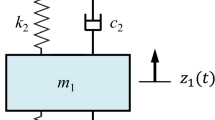Abstract
A novel identification technique for the extraction of lumped circuit models of general distributed or stray devices is presented. The approach is based on two multi-valued neuron neural networks used in a joined architecture able to extract hidden parameters. The convergence allows the validation of the approximated lumped model and the extraction of the correct values. The inputs of the neural network are the geometrical parameters of a given structure, while the outputs represent the estimation of the lumped circuit parameters. The method uses a frequency response analysis approach in order to elaborate the data to present to the net.










Similar content being viewed by others
References
Zhang, Q. J., Ton, L., & Cao, Y. (2007). Microwave modeling using artificial neural networks and applications to embedded passive modeling. In Proceedings of microwave and millimeter wave technology conference in ICMMT 2007 (pp. 1–4).
Avitabile, G., Chellini, B., Fedi, G., Luchetta, A., & Manetti, S. (2001). A neural architecture for the parameter extraction of high frequency devices. In Proceedings of IEEE International Symposium on Circuits and Systems in (ISCAS2001) Sidney, Australia May 2001.
Pratap, R., Staiculescu, D., Pinel, S., Laskar, J., & May, G. (2005). Modeling and sensitivity analysis of circuit parameters for flip-chip interconnects using neural networks. IEEE Transactions on Advanced Packaging, 28(2), 71–78.
Shinterimov, A., Tang, W. H., & Wu, Q. H. (2010). Transformer core parameter identification using frequency response analysis. IEEE Transactions on Magnetics, 46(1), 141–149.
Rashtchi, V., Rahimpour, E., & Rezapour, E. M. (2006). Using a genetic algorithm for parameter identification of transformer R-L-C-M model. Electrical Engineering, 88, 417–422.
Shinterimov, A., Tang, W. J., Tang, W. H., & Wu, Q. H. (2010). Improved modelling of power transformer winding using bacterial swarming algorithm and frequency response analysis. Electric Power Systems Research, 80, 1111–1120.
Tang, W. H., He, S., Wu, Q. H., & Richardson, Z. J. (2006). Winding deformation identification using a particle swarm optimiser with passive congregation of power transformers. International Journal of Innovations in Energy Systems and Power, 1(11), 46–52.
Aizenberg, I., Aizenberg, N. N., & Vandewalle, J. (2000). Multi-valued and universal binary neurons, theory, learning and applications. Dordecht: Kluwer Academic Publishers.
Fedi, G., Luchetta, A., Manetti, S., & Piccirilli, M. C. (1998). A new symbolic method for analog circuit testability evaluation. IEEE Transactions on Instrumentation and Measurement, 47(10), 554–565.
Aizenberg, N. N., & Ivaskiv, Y. L. (1977). Multiple-valued threshold logic. Kiev: Naukova Dumka Publisher House. (in Russian).
Aizenberg, I., Paliy, D., Zurada, J., & Astola, J. (2008). Blur identification by multilayer neural network based on multivalued neurons. IEEE Transactions on Neural Networks, 19, 883–898.
Aizenberg, I., & Moraga, C. (2007). Multilayer feedforward neural network based on multi-valued neurons (MLMVN) and a backpropagation learning algorithm. Soft Computing, 11, 169–183.
Aizenberg, I., Paliy, D., Zurada, J., & Astola, J. (2008). Blur identification by multilayer neural network based on multivalued neurons. IEEE Transactions on Neural Networks, 19(5), 883–898.
Aizenberg, I., & Moraga, C. (2007). The genetic code as a function of multiple-valued logic over the field of complex numbers and its learning using multilayer neural network based on multi-valued neurons. Journal of Multiple-Valued Logic and Soft Computing, 4–6(11), 605–618.
Aizenberg, I., & Zurada, J. (2007). Solving selected classification problems in bioinformatics using multilayer neural network based on multi-valued neurons (MLMVN). In J. Marques de Sá et al. (Eds.), Proceedings of the International Conference on Artificial Neural Networks (ICANN-2007), Lecture Notes in Computer Science, 4668, Part I, Springer, Berlin, Heidelberg, New York (pp. 874–883).
Lawson, C. L., & Hanson, R. J. (1974). Solving least squares problems. Englewood Cliffs, NJ: Prentice-Hall.
Golub, G. H., & Van Loan, C. F. (1996). Matrix computations (Vol. 3rd, p. 694). Baltimore, Md: Johns Hopkins University Press.
Householder, A. S. (1958). Unitary triangularization of a nonsymmetric matrix. Journal of the ACM, 5(4), 339–342.
Stoer, J., & Bulirsch, R. (1991). Introduction to numerical analysis (Vol. II). New York, Inc.: Springer-Verlag Publishers.
Aizenberg, I., Luchetta, A., & Manetti, S. (2012). A modified learning algorithm for the multilayer neural network with multi-valued neurons based on the complex QR decomposition. Soft Computing, 16(4), 263–275.
Fedi, G., Giomi, R., Luchetta, A., Manetti, S., & Piccirilli, M. C. (1998). On the application of symbolic techniques to the multiple fault location in low testability analog circuits. IEEE Transactions on Cicuits and Systems II, 45, 1383–1388.
Liberatore, A., Manetti, S., & Piccirilli, M.C. (1994). A new efficient method for analog circuit testability measurement. In Proceedings of IMTC’94, Hamamatsu, Japan (pp. 193–196).
Fedi, G., Manetti, S., Piccirilli, M. C., & Starzyk, J. (1999). Determination of an optimum set of testable components in the fault diagnosis of analog linear circuits. IEEE Transactions on Circuits and Systems—Part I, 46, 779–787.
Manetti, S., & Piccirilli, M. C. (2003). A singular-value decomposition approach for ambiguity group determination in analog circuits. IEEE Transactions on Circuits and Systems—Part I, 50(4), 477–487.
Sen, N., & Saeks, R. (1979). Fault diagnosis for linear systems via multifrequency measurement. IEEE Transactions Circuits and System, 26, 457–465.
Bartoli, M., Reatti, A., & Kazimierczuk, M. K. (1994). Modeling of ironpowder inductors at high frequencies. In Proceedings of the IEEE Industry Applications Conference in Denver, CO (pp. 1225–1232).
Roger, D., Napieralska-Juszczak, E., & Henneton, A. (2006). High frequency extension of non-linear models of laminated cores. International Journal Computation and Mathematics in Electrical and Electronics Engineering, 25, 140–156.
Fedi, G., Manetti, S., Pelosi, G., & Selleri, S. (2002). FEMtrained artificial neural networks for the analysis and design of cylindrical posts in rectangular waveguide. Electromagnetics, 22, 323–330.
Pelosi, G., Coccioli, R., & Selleri, S. (1998). Quick finite elements method for electromagnetic waves (pp. 89–113). London: Artech House.
Author information
Authors and Affiliations
Corresponding author
Rights and permissions
About this article
Cite this article
Grasso, F., Luchetta, A., Manetti, S. et al. System identification and modelling based on a double modified multi-valued neural network. Analog Integr Circ Sig Process 78, 165–176 (2014). https://doi.org/10.1007/s10470-013-0211-y
Received:
Revised:
Accepted:
Published:
Issue Date:
DOI: https://doi.org/10.1007/s10470-013-0211-y




